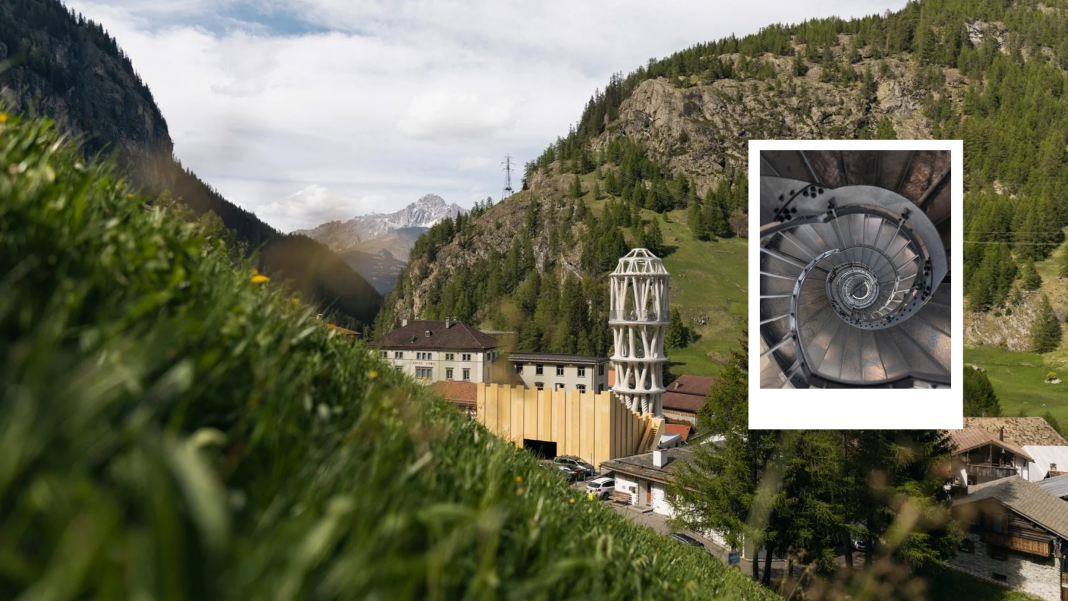A groundbreaking architectural marvel has emerged in the Swiss Alps: Tor Alva, a 30-metre-high tower crafted from 3D-printed concrete, recently unveiled in the tiny village of Mulegns. More than just a striking structure, Tor Alva is a symbol of innovation, culture, and sustainability, aimed at revitalising a village that today counts just 11 residents. Created through a collaboration between cultural foundation Nova Fundaziun Origen and ETH Zurich, the project pushes the boundaries of digital construction and promises a new future for rural communities.

A new landmark with a layered story
Tor Alva, or the White Tower, stands atop an old blacksmith’s workshop, where its four-tiered form resembles an ornate layered cake. This design pays homage to the local history, celebrating the legacy of confectioners from the Graubünden region who once migrated across Europe, spreading their craft. The tower’s unique aesthetic integrates seamlessly with the rugged mountainous landscape, a blend of natural beauty and high-tech innovation.
The unveiling was a dramatic affair, with the tower’s cover removed by helicopter, revealing the striking concrete columns to the world for the first time. Over the next five years, Tor Alva will remain a focal point in Mulegns, after which it will be carefully dismantled and reassembled at a new location, reflecting the sustainable and modular ethos of its creators.

Digital craftsmanship meets architectural innovation
Designed by architect Michael Hansmeyer alongside ETH Zurich professors Walter Kaufmann, Robert Flatt, and Benjamin Dillenburger, the project was brought to life with the help of the university’s spin-off company Mesh and construction firm Zindel United. The tower’s concrete components were 3D-printed over five months at ETH Zurich’s Hönggerberg campus, then transported to Mulegns for assembly.
This additive manufacturing process involves robots layering concrete and inserting steel reinforcement rings every 20 centimetres, supported by longitudinal steel bars added post-printing. Such techniques eliminate the need for traditional formwork, allowing for greater freedom in form and texture. The components fit together with removable screws and post-tensioning cables, enabling the tower to be disassembled and relocated with ease—a testament to forward-thinking construction design.

Engineering a new kind of concrete
A crucial part of the project’s success lies in the development of a specialised concrete mix by professor Robert Flatt. This mix hardens rapidly, allowing the layering process to proceed efficiently while maintaining structural integrity. Two additives are blended just before the concrete exits the pressurised nozzle, creating the tower’s distinctive droplet-like surface texture.
“Tor Alva showcases how digital construction techniques can be used to build load-bearing structures without formwork,” the team explained, highlighting the technical breakthrough that this project represents. A spiral staircase connects the tower’s levels, leading up to a domed top floor designed as a performance space, opening up new cultural possibilities for the village and beyond.

A beacon for sustainable culture and tourism
From Friday onwards, Tor Alva opens its doors to the public for guided tours and will later serve as a unique performance venue. Nova Fundaziun Origen’s founder, Giovanni Netzer, describes the tower as “more than a technical triumph” — a catalyst for inspiring the building industry, promoting sustainable tourism, and creating fresh cultural spaces.
Netzer was captivated by the blend of digital innovation, traditional craftsmanship, cultural heritage, and artistic expression embodied by Tor Alva. “It also gives a fading village a new chance. That’s extraordinary,” he remarked, underlining the project’s broader social and cultural significance.
3D printing’s growing footprint in architecture
Tor Alva is part of a broader movement exploring the potential of 3D printing in architecture. Recent landmark projects include Japan’s “world’s first” 3D-printed railway station, constructed in just six hours, and Texas’s soon-to-be-completed 3D-printed Starbucks.
In the UK, designer Arthur Mamou-Mani created Harmonic Tides, a 3D-printed installation inspired by water movement, unveiled at Clerkenwell Design Week. These projects, alongside Tor Alva, signal a new era in architecture—where digital fabrication, sustainability, and creativity converge to reshape how we build and inhabit spaces.
Tor Alva stands tall not only as the world’s tallest 3D-printed tower but also as a symbol of how cutting-edge technology can intersect with cultural memory and environmental responsibility, breathing new life into forgotten places while pioneering the future of construction.



